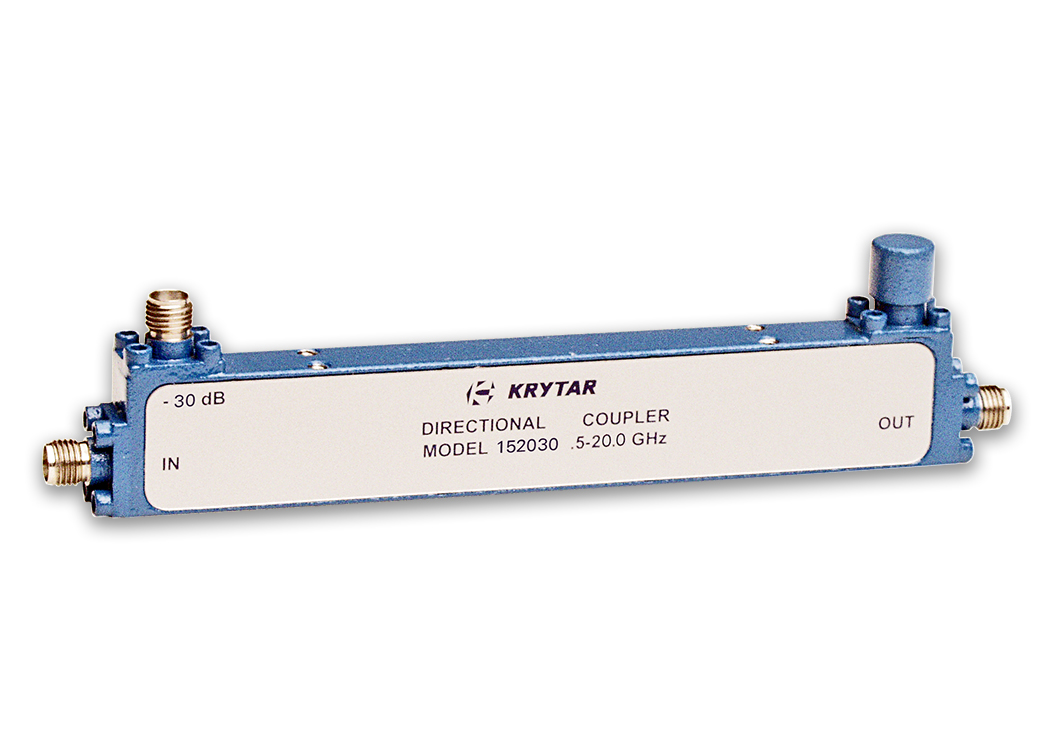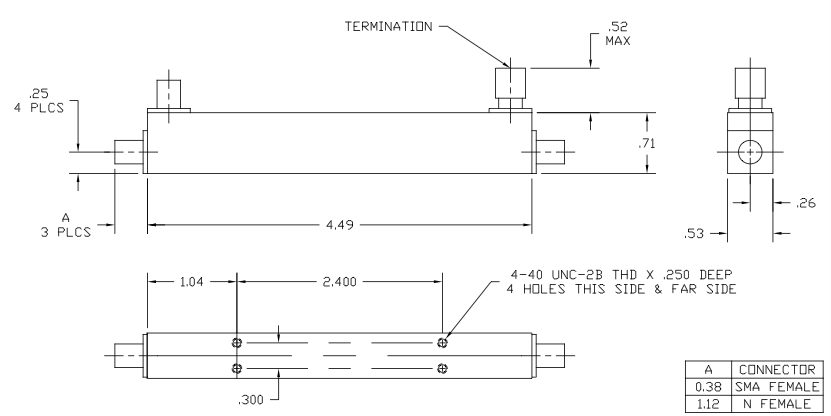Directional Couplers 152030
SPECIFICATIONS
Model Number
Freq. Min. (GHz)
Freq. Max. (GHz)
FEATURES
0.5 – 20.0 GHz Frequency Operation
30 dB Coupling
Frequency Sensitivity: ±1.8 dB
Compact Size
SMA Connectors
Custom Designs Available
Product Description
KRYTAR’s directional couplers are uniquely designed for systems applications where external leveling, precise monitoring, signal mixing or swept transmission and reflection measurements are required.
KRYTAR’s latest addition, Model 152030, enhances the selection of multi-purpose, stripline designs that exhibit excellent coupling over the wideband frequency range of 0.5 to 20.0 GHz in a single, compact and lightweight package.
In addition, Model 152030 offers superior performance ratings including Nominal Coupling (with respect to output) of 30 dB, ±1.8 dB, and Frequency Sensitivity of ±1.8 dB. The directional coupler exhibits Insertion Loss (including coupled power) of <1.35 dB, Directivity of >10 dB, Maximum VSWR (any port) is 1.35, Input Power Rating is 20 W average and 3 kW peak. The directional coupler comes with industry-standard SMA female connectors with optional N-Type Female connectors available. The compact package measures just 4.49 inches (L) x 0.53 inches (W) x 0.71 inches (H), and weighs only 3.1 ounces. Operating temperature is -54° to +85° C.
KRYTAR’s coupler is uniquely designed for systems applications where external leveling, precise monitoring, signal mixing or swept transmission and reflection measurements are required. KRYTAR couplers offer solutions for many wideband applications including electronic warfare (EW), commercial wireless, SATCOM, radar, signal monitoring and measurement, antenna beam forming, and EMC testing environments. For many space-restricted applications the compact size makes KRYTAR directional couplers ideal solutions. This wideband directional coupler can also be manufactured to meet ridged military specifications.
KRYTAR also offers complete engineering services for custom designs that meet or exceed critical performance and/or packaging specifications.
Common Definitions
|
Microwave Frequency Bands
|
|
| Band Designation | Frequency Range (GHz) |
| UHF | 300 MHz – 1.0 GHz |
| L | 1.0 – 2.0 |
| S | 2.0 – 4.0 |
| C | 4.0 – 8.0 |
| X | 8.0 – 12.0 |
| DBS | 12.2 – 12.7 |
| Ku | 12.0 – 18.0 |
| K | 18.0 – 26.5 |
| Ka | 26.5 – 40.0 |
| Q | 30.0 – 50.0 |
| U | 40.0 – 60.0 |
| V | 50.0 – 75.0 |
Directional Couplers: Components that allow two microwave circuits to be combined into one integrated system in one direction with the two completely isolated from each other in the opposite direction.
Dual-Directional Couplers are 4-port couplers that are the combination of two 3-port couplers having their main lines cascaded.
Couplers are passive microwave components used for distributing or combining microwave signals. Directional couplers are four-port circuits where one port is isolated from the input port.
The coupled port on a microstrip, or stripline directional coupler, is closest to the input port because it is a backward wave coupler. On a waveguide broadwall directional coupler, the coupled port is closest to the output port because it is a forward wave coupler.
Gigahertz (GHz): A unit of measurement denoting the number of cycles in one second. One GHz is one billion cycles every second.
Megahertz (MHz): Equal to 1 million Hz. Uses the SI Prefix Mega, meaning 10^6.
VSWR (Voltage Standing Wave Ratio): The ratio of the maximum voltage to the minimum voltage in standing wave pattern along the length of a transmission line structure. It varies from 1 to (plus) infinity and is always positive. VSWR can be converted to return loss or the reflection coefficient.
Insertion Loss: In telecommunications, Insertion Loss is the loss of signal power resulting from the insertion of a device in a transmission line or optical fiber and is usually expressed in decibels, or dB.
Isolation: In telecommunications, Isolation refers to the ability to prevent a signal from appearing at a node in a circuit where it is unwanted and is expressed in decibels, or dB.
Operating Temperature: An operating temperature is the temperature at which an electrical device operates. The device will operate effectively within a specified temperature range which varies based on the device function and application context, and ranges from the minimum operating temperature to the maximum operating temperature (or peak operating temperature). Outside this range of safe operating temperatures the device may fail.
5G
The fifth generation (5G) of cellular service, superseding 4G LTE. Governed by the 3GPP, 5G will increase transmission speed dramatically and embrace prioritization. As wireless data increases exponentially, real-time content such as video calling and video streaming must be given a higher priority than data on Web pages.
5G NR (5G New Radio)
The 5G new radio access technology (RAT) air-interface is a global standard, which like 4G also uses OFDM modulation, and is designed to deliver data rates up to 20 Gbps, enabling individual users to get gigabit-per-second downloads over the air (OTA). Wireless virtual reality (VR) and augmented reality (AR) can become commonplace, and 5G is expected to provide a huge boost for connecting billions of Internet of Things (IoT) devices.
Wi-Fi 6
Wi-Fi 6 is the most recent iteration of the IEEE standard for wireless local-area network (WLAN) protocol and is a substantial upgrade over its predecessors Wi-Fi 4 and Wi-Fi 5. Wi-Fi 6 operates between 2.4 GHz and 5 GHz. Wi-Fi 6 can be significantly faster due to technologies like traffic prioritization, OFDMA, and beamforming.
Wi-Fi 6E
Wi-Fi 6E operates at 6 GHz (5.925–7.125 GHz in the U.S.) and also the 2.4 GHz or 5 GHz devices already in use. Wi-Fi 6E-enabled devices can take advantage of the newer 6 GHz frequency band for further improved connectivity.
Additional Resources
For more information on KRYTAR’s Couplers please see below:
- Directional Couplers Primer
- Microwave or RF Amplifier Test Setup
- KRYTAR Directional Couplers: Term Definitions, Testing, and Typical Applications
- 180-Deg. Hybrids Control Signals From 2 to 20 GHz, Microwaves & RF article
- Broadband, 3dB 90° Hybrids Cover 1 to 18 GHz, Microwave Journal article
- KRYTAR 180 Degree Hybrids Control Signals from 1 to 26.5 GHz
- KRYTAR 180 Degree Hybrids testing and term definition



